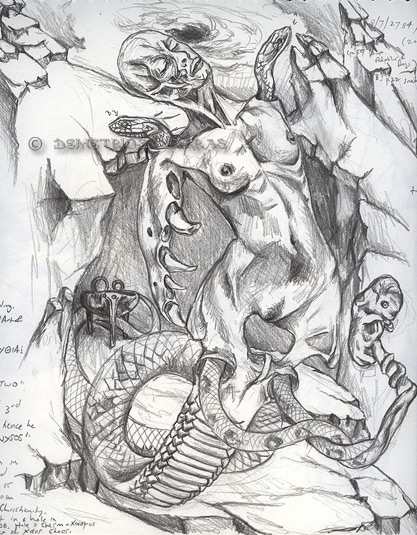Πυθία Pythia, drawing, graphite on paper, 2008
On the Pythia:
In Greek myth her lair is at the earth's navel which is located
in Delphi. And, according to Greeks, she binds every
living being to the cosmos. It is by her, the Pythia
from Delphi, that biological relationships in Greek are
understood and are so referred to as Delphian. In Greek, the word "sibling" is "adelphia" (ie philadelphia, the love of a sibling), that is, "from Delphi". Located at the world navel the Pythia is then a cosmic umbilicus.
Her earliest appearance in literature is in the Homerica, the cycle of poems
which in antiquity were attributed to Homer.
The composition of these poems are now attributed
to various authors other than Homer and ascribed
largely to the 7th century BC. In the Ode to the Pythian Apollo, the god Apollon kills the Pythia, who according to this poem nurtured the monster
Typhon who so nearly destroyed the cosmos.
(This genealogy ascribed to Typhon is in conflict
with that given by Hesiod and other Greek authors).
After killing her,
"Apollo boasted over her:
'Now rot here upon the soil that feeds man...
here shall the Earth and shining Hyperion make you rot..'
And the holy strength of Helios made her rot away there; wherefore
the
place is now Pytho, and men call the lord
Apollo by another name, Pythian; because on that
spot the power of Helios made the monster rot away."
lines 362-375, Evelyn-White translation.
By killing the Pythia Apollon acquired his powers of prophecy born of the underworld
- in his northern guise Apollon is none other
than Odin (but that is another essay).
|
|
|
|
|
|
the pythia and her associated components
- the chaos (gap), top, is the Byzantine gap from which the "hand of god" emerges. This Byzantine Christian feature was derived directly from Classical
Greek ("pagan") religion. It is from this gap that the 3 kyklopes ("round-eyes", cyclopes) in Greek ("pagan") religion fashion the lightning-weapon of Dios (God, "Zeus"). This Greek (pagan) idea was the prism through which Greek Byzantine Christians
understood and represented YHWH-cum-Jesus;
- the tripod in the cave is the one that Apollon takes possession of after he
kills its python (serpent) -guard. Apollon,
like Odin, assumes the power of prophecy;
- the cave my Pythia is situated in is the cave in which Byzantines situate the
divine. It is in a cave that the birth
of Jesus is depicted by Byzantines. This
cave is none other than the Diktean (Dictean)
cave of Zevs ("Zeus"), which is also the chasmos (chasm) of Pythia.
|
|
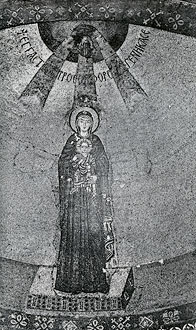 |
|
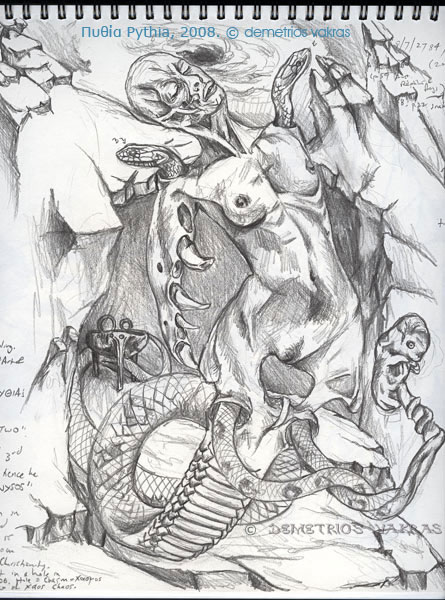 |
|
|
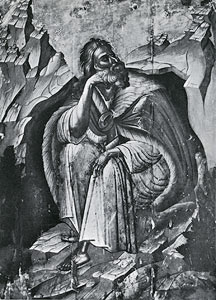 |
|
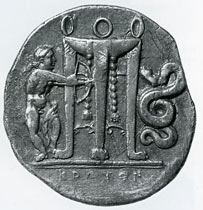 |
|
|
- my Pythia is composed of 3 entwined snakes as is the serpent pillar originally
from Delphi.
The interchangeability of the serpent and the feminine as understood by the Greeks
("pagans") is represented in the metamorphosing of the serpentine into the human, the
human into the serpentine.
She also represents fertility. This is symbolised by
the foetus.
This drawing reclaims the Greek (pagan) ideas, appropriated by Christians, to
restore to these symbols their original
meaning.
|
|
| Apollon attacking the Python at Delphi. Silver stater from Kroton, c. 420 BC.
Illus. 104, Art and Myth in Ancient Greece, T. H. Carpenter |
|
|
|
|
|
|
|
|
|
right: Remnants of Serpent column, Constantinople.
http://en.wikipedia.org/wiki/Image:Snake_column_Hippodrome_Constantinople_2007.jpg
The serpent column was set up in Delphi on behalf of the Pythia. Its stone base
has been located at Delphi.
It was still there when
visited by Pausanias in
the 2nd century AD when
he describes the gold tripod
placed on the top of the "bronze snake" (Book X, 13.4). The serpent pillar was taken by Constantine to the city he renamed
after himself and was placed
in front of the original
Hagia Sophia. It was later
moved to the Hyppodrome.
|
|
|
|
|
The serpent column survives, though much mutilated (its heads are missing) in
Constantinople now called "Istanbul" by the Turks. (The Arab author Al-Ma'udi wrote on the name by which the Arabs
referred to Constantinople: "The Rum call it 'bolin' [πόλις, polis, that is, "city"], and when they wish to express its greatness as the capital of the empire,
they say 'estin bolin'. The Rum do
not call it al-Kustantiniyya; only
the Arabs do so." From Byzantium Viewed by the Arabs, N. M. el Cheikh. It is evident that Al-Ma'udi did not know Greek. The term "estin bolin" is a rendition of the Greek "εις την πόλιν", "to the city" and is not a means by which the city's greatness is expressed. The Turks renamed
the city of Constantine in order to
stamp their ownership over it, to make
it Turkish, by giving it ... a Greek
name.)
Left: Sweepers at the Hippodrome, with the Serpent Column in the foreground.
From the Surnama of Murad III (1574-95). Illus.
212 Islamic Art, D. Talbot-Rice. Nearly 150 years after the conquest of Constantinople by the
Turks, the "serpent pillar" was still intact.
|
the pythia belongs to my Mytheic Series.

© demetrios vakras

|


![]()
